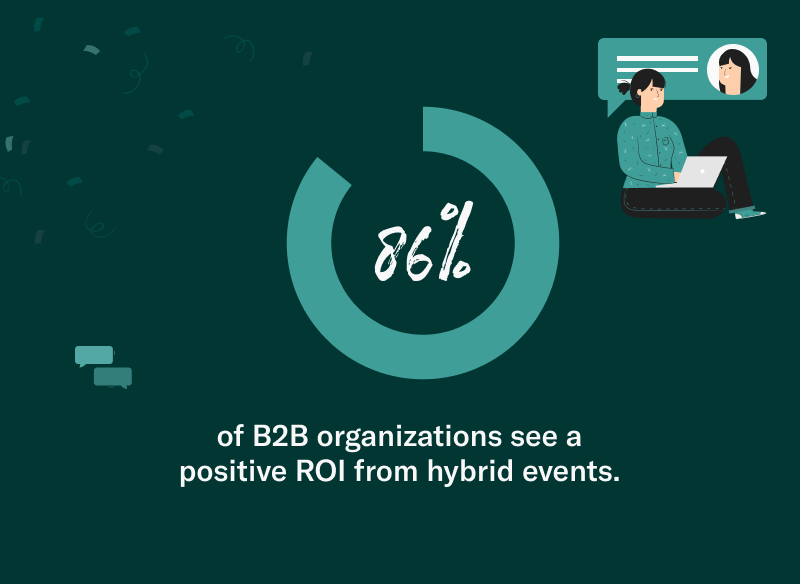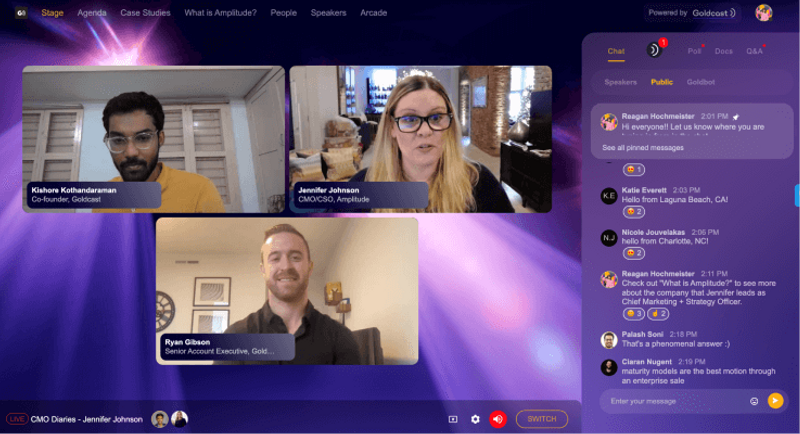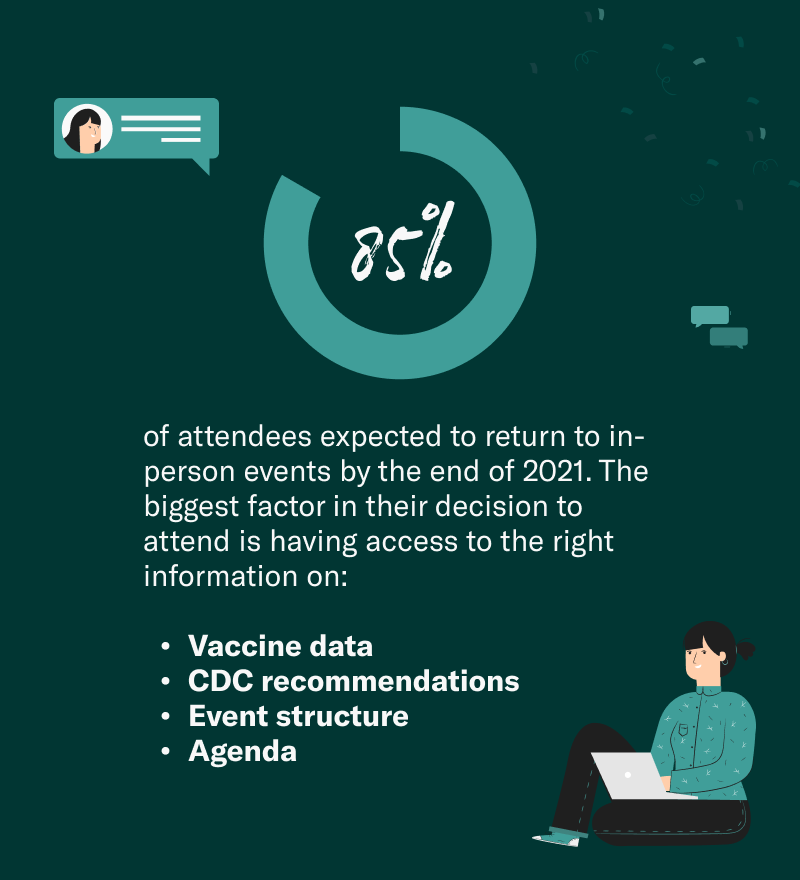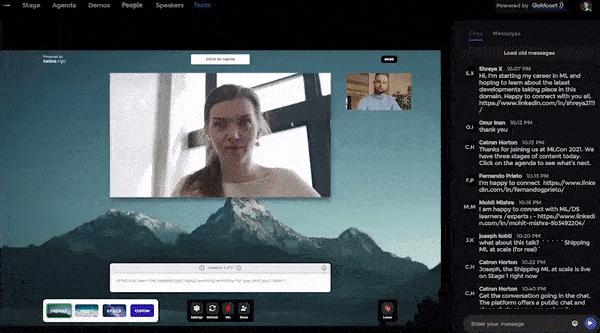The Return of In-Person Events — Pivoting from Virtual to Hybrid

Table of Contents
Maximize Your Marketing ROI
Join 10,000 other marketers already getting the best tips on running engaging events that boost pipeline and create raving fans.
If you’re like most modern field marketers, you’re probably more than a little excited about the imminent return to in-person events. Because, let’s be honest, the last two years have been a heckuva rocky road (and we’re not talking yummy, marshmallowy goodness).
But with all the new things to think about in a post-pandemic world, venturing back into an in-person setting can definitely feel more than a little bit daunting.
Luckily, hybrid events present the perfect opportunity to test the waters while continuing to leverage the benefits of virtual events.
In this ultimate guide to prepping the perfect return to in-person — via a powerful hybrid event — we’ll cover all the hybrid essentials, top tips for acing the game, and the extras you’ll be glad you thought of.
Ready to dive in? Let's go!
Here’s what we’ll cover:
- Why returning to in-person begins with hybrid
- In-person + virtual: The ultimate hybrid event checklist ✅
- 3 tips to elevate your return to in-person events
Why returning to in-person begins with hybrid
While the format of hybrid events can vary, their definition is pretty straightforward.
One part virtual and one part in-person, hybrid events allow for bigger audience numbers, more engagement opportunities and an all-round epic event experience.
And with 86% of B2B organizations seeing a positive ROI from hybrid events, it’s no wonder they’re a hit with revenue-focused field marketers.

Here are just a few of the big benefits hybrid has to offer:
- Access a global audience
- Cater to invitees individual needs
- An ultra-engaging attendee experience for everyone
- Awesome holistic event data
- Account-level insights to fuel personalized follow-ups
- Reduced carbon footprint
“We incorporate elements of both in-person and virtual events into our strategy, to appeal to attendees who are comfortable joining in-person, without excluding those who are not,” explains Stefanie Maragna, VP of Corporate Marketing & Events at Sage Intacct.

Whether you run your virtual and in-person event streams concurrently, or you take a sandwich approach to your hybrid event and utilize your in-person content later at a virtual event — there’s a hybrid format to suit all types of event goals and strategies.
In-person + virtual: The ultimate hybrid event checklist ✅
Bringing you the best of an in-person experience combined with the powerful data of a virtual event, hybrid events have cemented their place in today’s field marketing playbook.
But that doesn’t mean they’re easy.
In fact, experts like event marketing legend Lisa Gregory say, “It's really hard to get the actual full-fledged benefits out of both.”To ensure your transition is a smooth one, let’s get the basics covered.
✔️ Make safety priority #1
As an event marketing pro you know that the attendee experience is everything. And in a world where Covid variants are a seemingly never-ending source of anxiety, safety has to be your priority.Audit your event’s Covid compliance profile with 7 simple steps:
- Follow CDC guidance — this changes regularly, so be sure to keep up.
- Require or offer Covid testing before the event.
- Invest in masks and sanitizer — brand them for extra brand cred.
- Enable contract tracing and keep it super accurate.
- Mandate social distancing — no handshakes and hugs here please.
- Create a one-way system for your event flow, to limit touchpoints.

Source: Freeman
✔️ Make sure your in-person venue is hybrid-optimized
Now that in-person is back on the scene, so are venue options. But this time wIth even more to consider. Here are a few questions to ask when vetting venues:
- Does the venue have space to socially distance?
- Does the contract cover Covid-related cancellations?
- Will your insurance cover the cost if guidance changes?
- Do they offer safe catering options?
- Do they have their own Covid precautions (and what are they)?
- Does the venue require masks and/or vaccination passports?
- Is their stage setup streamable – lighting, speakers, camera distance, etc.?
- Do they have stream-worthy wifi strength?
- How much access will you have before the event to set up your tech?
- Do they have enough screens to facilitate:
- Speaker content
- Engagement display (poll answers, Q&As, social media stream, etc.)
- Virtual attendee interaction — remote audience stream
Before you sign anything, make sure your questions are covered.
✔️ Schedule wisely
Klaviyo’s Head of Global Brand Events, Morgan Laskey, knows the event game has changed. “Our community is busy running online businesses, so convenience is key to them engaging in our events,” she says.
With no flight schedules or commutes to juggle, scheduling a virtual event is fairly simple. But when it comes to in-person, there’s a lot more to think about.
Take a broad view of your best scheduling options to make sure you’re accommodating both your in-person and virtual attendees.
- Review past attendee data (in-person and virtual) for signals on the best date and time to host your hybrid event.
- Avoid Mondays and Fridays. There’s generally too much going on at the beginning and end of the week.
- Test the waters with your first few events to see what works best for your attendees.
✔️ Treat your hybrid event as two separate events
There’s no way to sugarcoat it. If you want to excel at hybrid, it’s going to take double the work.
While they may run in parallel, use the same content and share the same information, the truth is the experience has to be different for your in-person vs. virtual audience.
Equal. But different.
Experts like Sarah Stealey Reed, Senior Director of Global Strategic Events at Zendesk, are all too familiar with the challenge.
“Pre-pandemic most of us made poor hybrid decisions, live-streaming the keynote and calling it good. That clearly doesn't work anymore — it never should have. Now we're recognizing that hybrid means at least two experiences for every event,” says Sarah.
No matter which hybrid format you choose, make sure you take the time to:
- Define the roles involved in planning a virtual event and assign them to the best team members for the job.
- Make sure the rest of the team knows how to ace the in-person portion.
- Examine the core areas of overlap and map out who passes the baton to whom, and at which moments throughout the event.

✔️ Increase your budget
As you might imagine, hosting two events can easily be more expensive than hosting one — especially if you’re coming out of a virtual-only events program.
But if you’re going to do hybrid right, don’t over-index on the in-person budget at the expense of your virtual attendees. Both experiences have to be equally engaging.
Here are some actionable budget tips from our network of event pros:
- Try Lisa Gregory’s calculation: (Virtual event budget + in–person budget) * 20% for extra production elements = hybrid event budget.
- Or her bonus tip: If you’re hiring an external consultant, factor in that they’ll charge double to run two events simultaneously.
- If budget is tight, Sarah Stealey Reed says to, “Keep your money in digital-first and supplement with small, in-person gatherings that are less show and more purpose.”
- Stefanie Maragna’s money-saving tip is all in your tech choices — “I firmly believe that an all-in-one hybrid event management platform is key to running a great hybrid event — and it can help you cut down on event costs too.”
✔️ Use your virtual event data to inform your in-person strategy
You’ve been playing your virtual event cards for months, if not years. And if you’ve been using the right platform, you should have some pretty solid data tucked away.
It’s important to note that that data doesn’t suddenly become irrelevant when you make the leap to hybrid. In fact, it can be used to elevate the attendee experience — and your revenue.

Use your event data to answer the following questions:
- Which sessions got the most engagement during your virtual event?
- Which sessions could you stand to lose or modify?
- What activities or features worked best in a virtual setup? (Think: Q&A, polls, booths, chats, etc.)
- What were the most downloaded resources?
- How long did attendees stay at the event?
- How many registrations did you receive on certain days vs. others?
- How many engagements did you get from a certain audience segment?
- How many demos did you perform?
If you out-performed in a specific area virtually, don’t be afraid to double down on that in-person. And if something didn’t work, scrap it!
3 tips to elevate your return to in-person events 🙌
If you can tick off all the above, you’re on your way to hybrid success.
But when you sit down to start your journey, it’s important to keep these three simple tips in mind:
- You’ve got to be flexible: From in-person, to virtual, and now to hybrid — event marketing has been all about the pivot. If you’re still rocking the event scene, you’ve made it. So keep up the great work!
- You need a solid back-up plan: With hybrid and in-person events, there’s a lot that might not go to plan. Prepare for every scenario ahead of time and have a back-up (or 10) just in case.
- The right technology can make all the difference: Virtual event platforms are a dime a dozen. Few stand out from the crowd. Find one that has the hybrid capabilities and customer support you can rely on. And don’t settle until you find it.
“The recipe is slightly different for everybody. But talking about the ingredients is half the battle.”
In the eyes of our friend Lisa Gregory, no two hybrid events will look exactly the same.
“This is an opportunity to build the best dessert you can. Let's figure out, as a community, what that looks like. That recipe is slightly different for everybody. But talking about the ingredients is half the battle,” she says.
At the end of the day, a hybrid event program that’s successful for one company, won’t necessarily work for the next.
But by having the basics covered and opening up the hybrid conversation to new ideas and opportunities, finding the perfect recipe for your return to in-person strategy can be a whole lot easier.

Transform Your Video Marketing with AI
Stay In Touch
Platform
Resources
© 2026 Copyright Goldcast, Inc. All rights reserved.





 Upcoming Events
Upcoming Events Event Series
Event Series On-Demand Events
On-Demand Events

